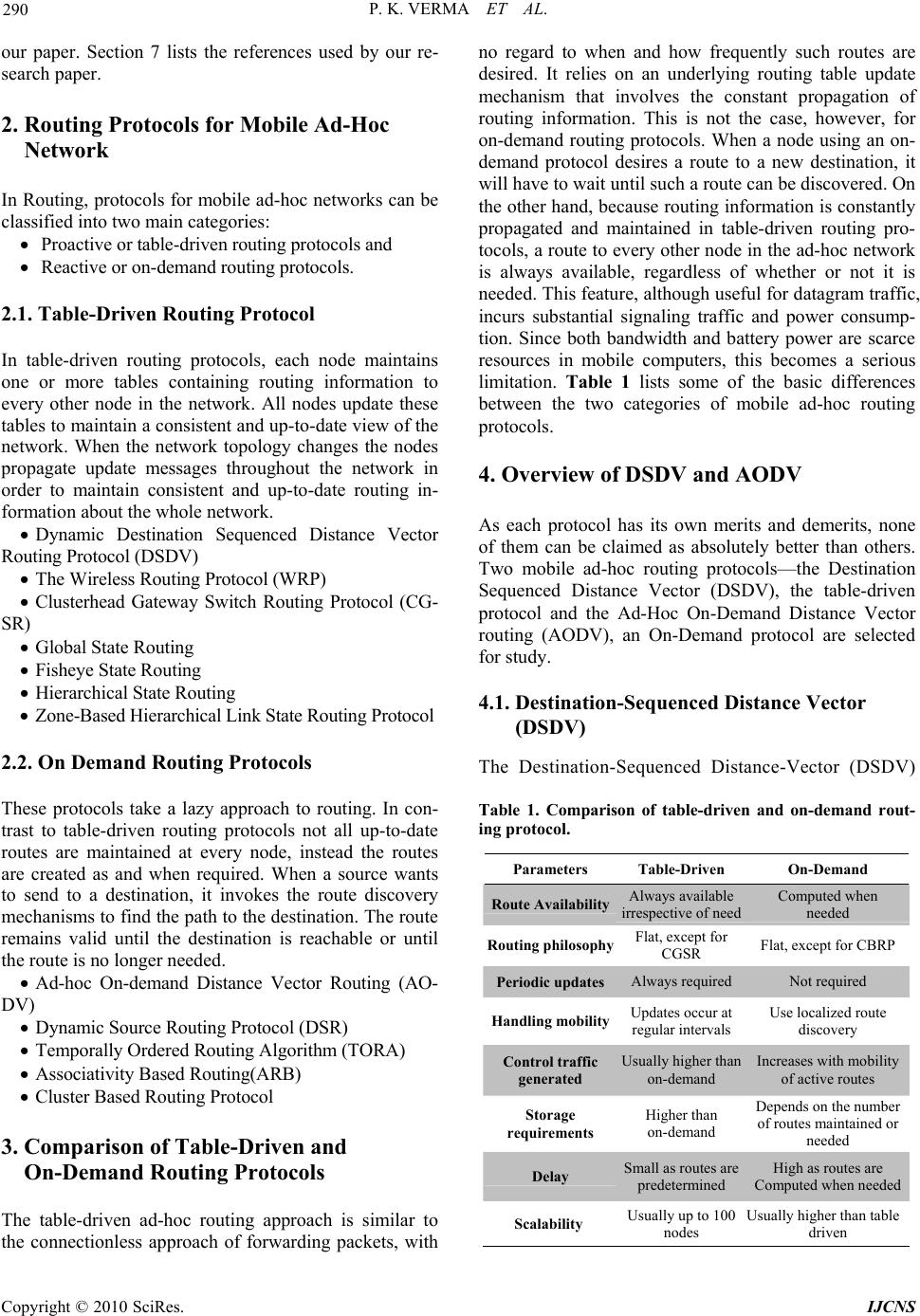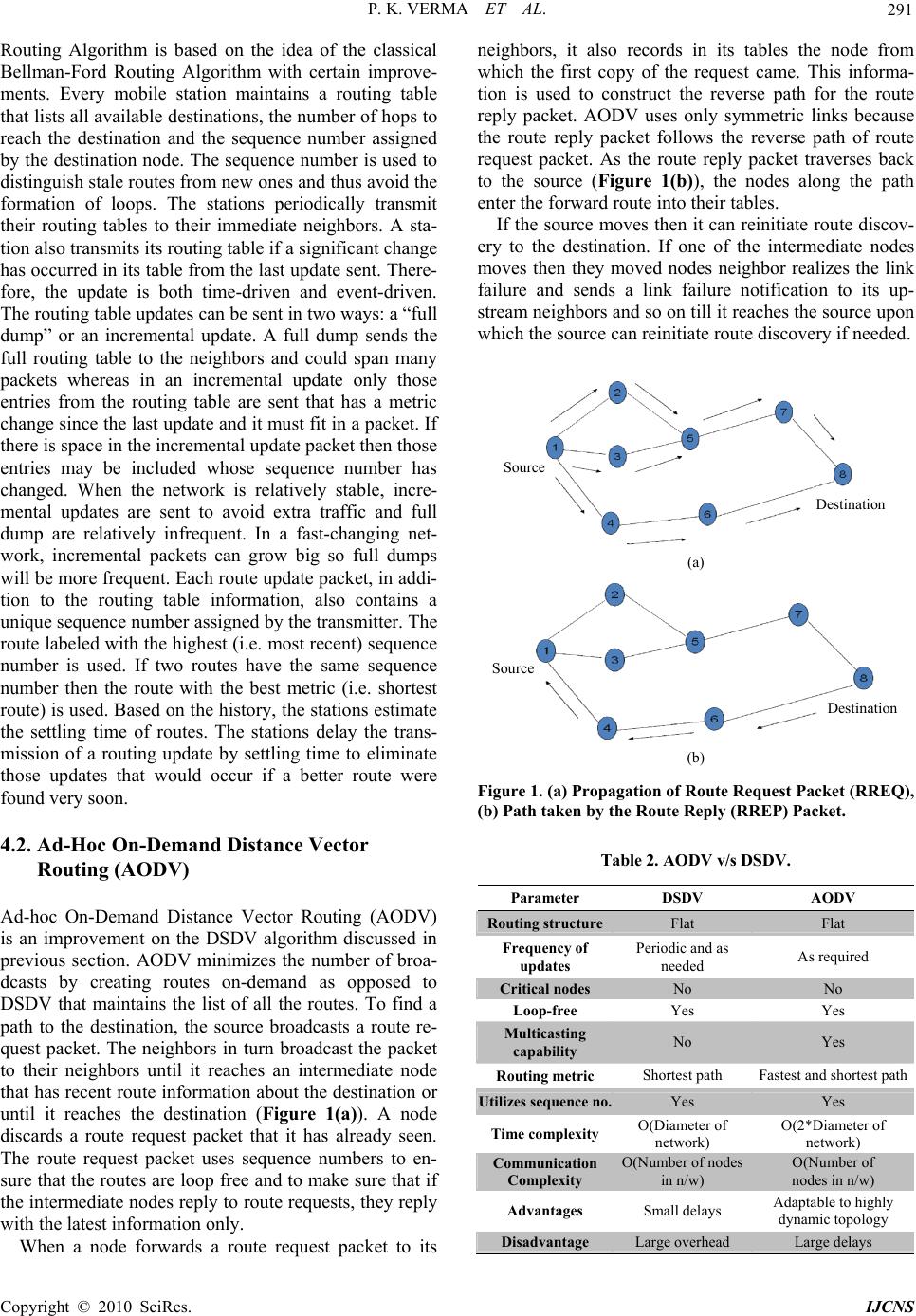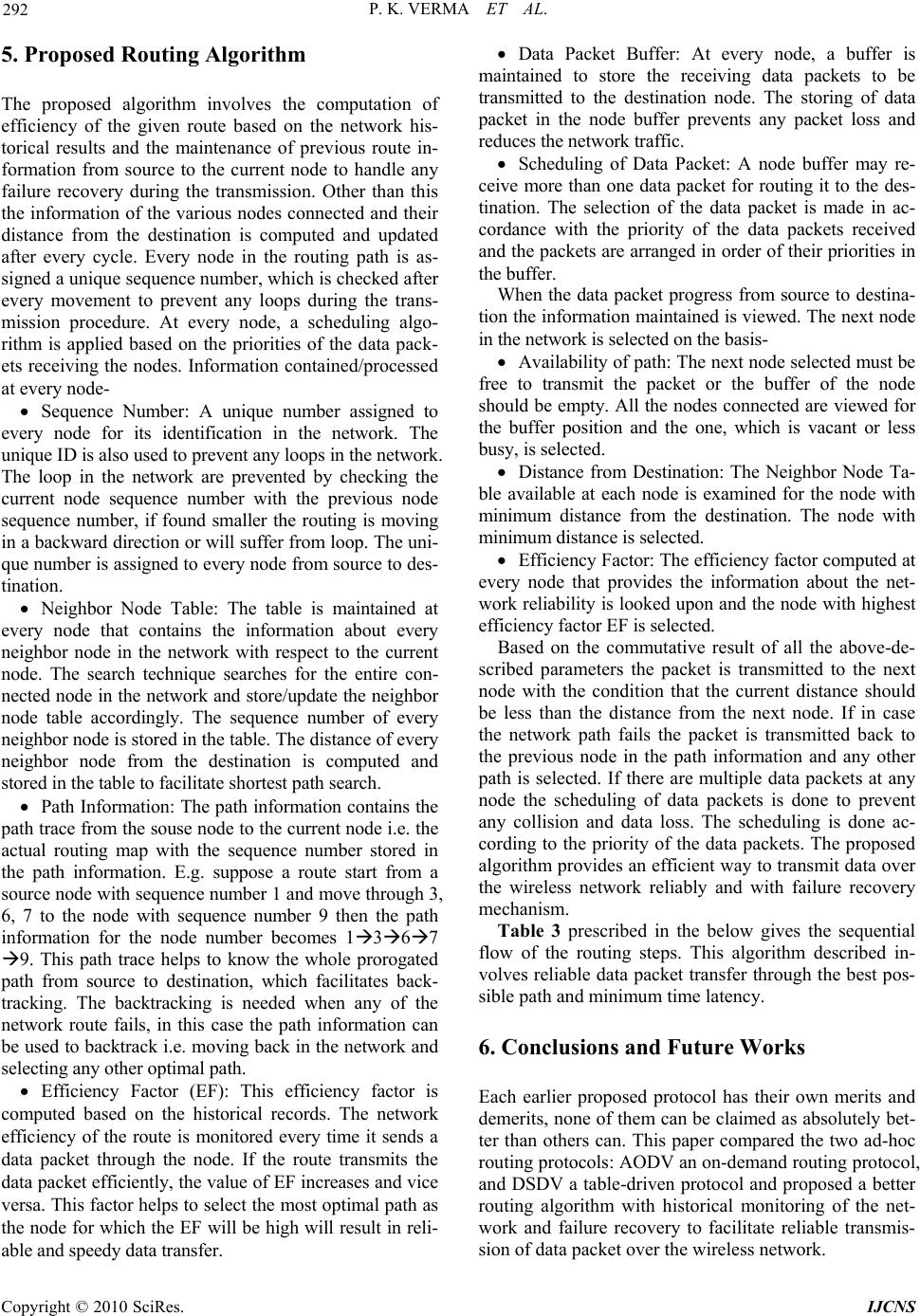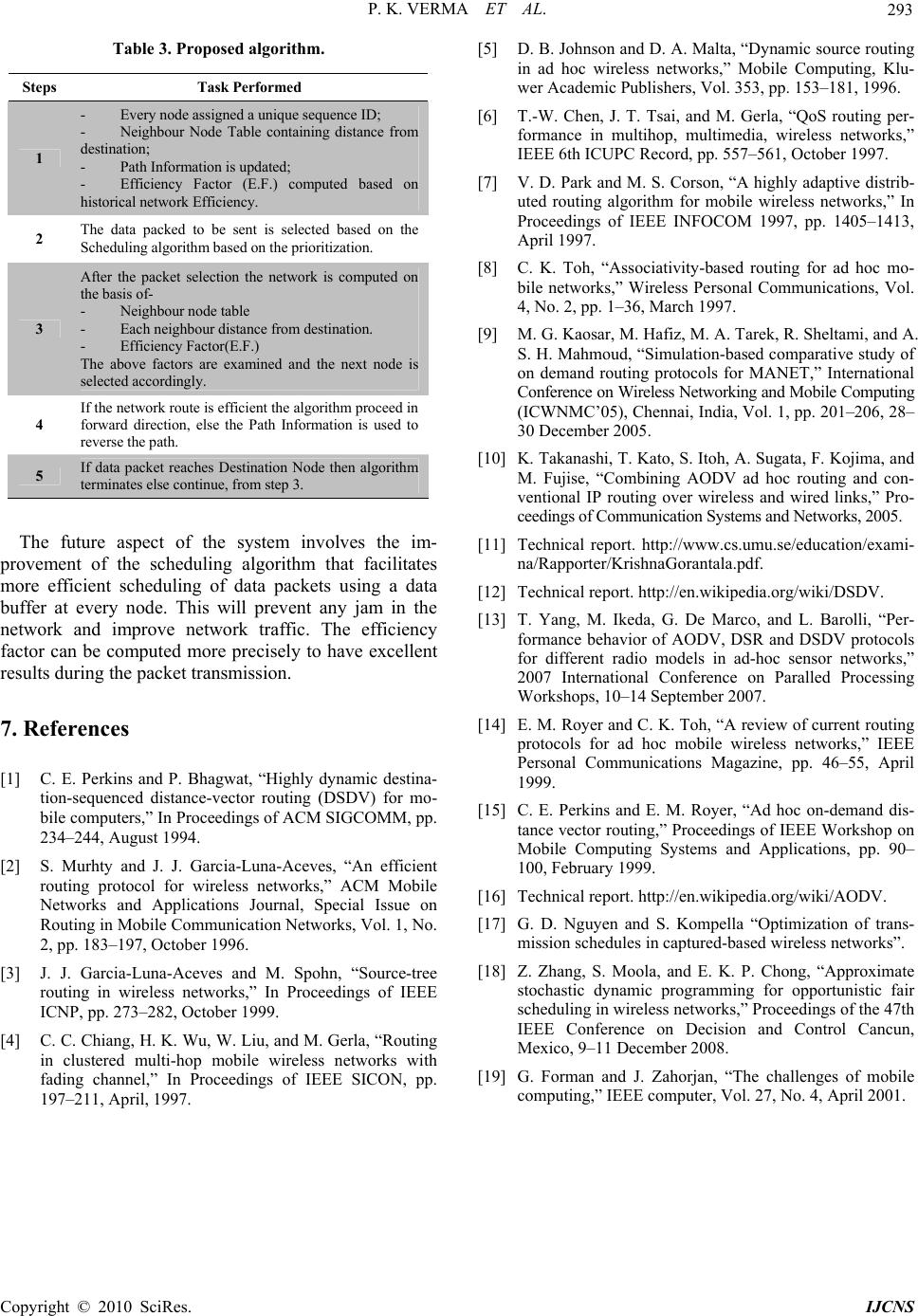Paper Menu >>
Journal Menu >>
 Int. J. Communications, Network and System Sciences, 2010, 3, 289-293 doi:10.4236/ijcns.2010.33037 blished Online March 2010 (http://www.SciRP.org/journal/ijcns/). Copyright © 2010 SciRes. IJCNS Pu A Mobile Ad-Hoc Routing Algorithm with Comparative Study of Earlier Proposed Algorithms Pawan Kumar Verma, Tarun Gupta, Nitin Rakesh, Nitin Nitin Department of C SE & IT, Jay pee Uni versi ty of Information Tech nology, Wakna gh at, I ndia E-mail: nitin.rakesh@gmail.com, delnitin@ieee.org Received December 10, 2009; revised January 12, 2010; accepted Febru a r y 16, 2010 Abstract A mobile ad-hoc network is an autonomous collection of mobile nodes that communicate over bandwidth constrained wireless links. Due to nodal mobility, the network topology may change rapidly and unpredicta- bly over time. The routing protocols meant for wired network cannot be used for mobile ad-hoc network be- cause of mobility of network. A number of routing protocols like Destination-Sequenced Distance-Vector (DSDV), Ad-Hoc On-Demand Distance Vector (AODV), Dynamic Source Routing (DSR), and Temporally Ordered Routing Algorithm have been implemented. The ad-hoc routing protocols can be divided into two classes; Table-Driven and On-Demand. This paper examines two routing protocols for mobile ad-hoc net- works—the Destination Sequenced Distance Vector (DSDV), the table-driven protocol and the Ad-Hoc On- Demand Distance Vector routing (AODV), an on-demand protocol and propose an algorithm that facilitates efficient routing of the packet and failure recovery mechanism. Keywords: AODV, DSDV, Relative Performance 1. Introduction and Motivation Wireless networks are the current field of research as it provides new advancement to the field of mobile net- work and reliable data transfer. They provide a mecha- nism to share the information and services via electronic medium without any geographical constraints. As the medium is wireless there is no distance limitations pre- sent and the network do not need much maintenance as no physical medium is involved in the actual transmis- sion. Wireless networks can be categorized as-infrastructured network and infrastructure less (ad-hoc) networks. Infrastructured network consists of a network with fixed and wired gateways. A mobile host searches for a bridge in the network in its defined communication radius, if it goes out of the range of the network the search for new base station starts and the communication is established. The approach is called as handoff. In contrast to infrastructure-based networks, in ad-hoc networks all nodes are mobile and can be connected dy- namically in an arbitrary manner. All nodes of these networks behave as routers and take part in discovery and maintenance of routes to other nodes in the network. Ad-hoc networks are very useful in emergency search- and-rescue operations, meetings or conventions in which persons wish to quickly share information, and data ac- quisition operations in inhospitable terrain. Routing pro- tocols for mobile ad-hoc networks can be classified into two main categories: Proactive or table driven routing protocols and reactive or on-demand routing protocols. In proactive protocols, every node maintains the network topology information in the form of routing tables by periodically exchanging routing information. They in- clude the Destination Sequenced. Distance Vector (DSDV) [1], the Wireless Routing Protocol (WRP) [2], Source-Tree Adaptive Routing (STAR) [3] and Cluster-head Gateway Switch Routing Protocol (CGSR) [4]. On the other hand, reactive proto- cols obtain routes only on demand, which include the Dynamic Source Routing (DSR) protocol [5], the Ad-hoc On-demand Distance Vector (AODV) protocol [6], the Temporally Ordered Routing Algorithm (TORA) [7], and the Associati vi t y Based R out i n g (AB R) protocol [8] . The rest of the paper is organized as follows: Section 2 presents an overview of the two main categories of mo- bile ad-hoc routing protocols and Section 3 presents a general comparison of the table-driven and on-demand routing protocols. Section 4 provides an overview and general comparison of the routing protocols used in the study. In Section 5, we propose routing algorithm with better performance and failure recovery. Finally, Section 6 concludes the paper and describes the future work of  P. K. VERMA ET AL. 290 our paper. Section 7 lists the references used by our re- search paper. 2. Routing Protocols for Mobile Ad-Hoc Network In Routing, protocols for mobile ad-hoc networks can be classified into two main categories: Proactive or ta ble-dri ven ro uting protocol s and Reactive or on-demand routing protocols. 2.1. Table-Driven Routing Protocol In table-driven routing protocols, each node maintains one or more tables containing routing information to every other node in the network. All nodes update these tables to maintain a consistent and up-to-date view of the network. When the network topology changes the nodes propagate update messages throughout the network in order to maintain consistent and up-to-date routing in- formation about the whole network. Dynamic Destination Sequenced Distance Vector Routing Prot ocol (DSDV) The Wireless Routi ng Protocol ( WRP) Clusterhead Gateway Switch Routing Protocol (CG- SR) Global State Rout ing Fisheye State Routing Hierarchical State Routing Zone-Based Hierarchical Link St ate R outing Prot ocol 2.2. On Demand Routing Protocols These protocols take a lazy approach to routing. In con- trast to table-driven routing protocols not all up-to-date routes are maintained at every node, instead the routes are created as and when required. When a source wants to send to a destination, it invokes the route discovery mechanisms to find the path to the destination. Th e route remains valid until the destination is reachable or until the route is no longer needed. Ad-hoc On-demand Distance Vector Routing (AO- DV) Dynamic Sour ce R out ing Protocol (DSR) Temporall y Ordered Routing Algorithm (TORA) Associativity Based Routing(ARB) Cluster B a sed R out i ng Protocol 3. Comparison of Table-Driven and On-Demand Routing Protocols The table-driven ad-hoc routing approach is similar to the connectionless approach of forwarding packets, with no regard to when and how frequently such routes are desired. It relies on an underlying routing table update mechanism that involves the constant propagation of routing information. This is not the case, however, for on-demand routing protocols. When a node using an on- demand protocol desires a route to a new destination, it will have to wait until such a route can b e discovered . On the other hand, because routing information is constantly propagated and maintained in table-driven routing pro- tocols, a route to every other node in the ad-hoc network is always available, regardless of whether or not it is needed. This featu re, although useful for datag ram traffic, incurs substantial signaling traffic and power consump- tion. Since both bandwidth and battery power are scarce resources in mobile computers, this becomes a serious limitation. Table 1 lists some of the basic differences between the two categories of mobile ad-hoc routing protocols. 4. Overview of DSDV and AODV As each protocol has its own merits and demerits, none of them can be claimed as absolutely better than others. Two mobile ad-hoc routing protocols—the Destination Sequenced Distance Vector (DSDV), the table-driven protocol and the Ad-Hoc On-Demand Distance Vector routing (AODV), an On-Demand protocol are selected for study. 4.1. Destination-Sequenced Distance Vector (DSDV) The Destination-Sequenced Distance-Vector (DSDV) Table 1. Comparison of table-driven and on-demand rout- ing protocol. Parameters Table-Driven On-Demand Route AvailabilityAlways available irrespective of need Computed when needed Routing philosophyFlat, except for CGSR Flat, except for CBRP Periodic updatesAlways required Not required Handling mobilityUpdates occur at regular intervals Use localized route discovery Control traffic generated Usually higher th an on-demand Increases with mobility of active routes Storage requirements Higher than on-demand Depends on the number of routes maintained or needed Delay Small as routes are predetermined High as routes are Computed when needed Scalability Usually up to 100 nodes Usually higher than table driven Copyright © 2010 SciRes. IJCNS  P. K. VERMA ET AL. 291 Routing Algorithm is based on the idea of the classical Bellman-Ford Routing Algorithm with certain improve- ments. Every mobile station maintains a routing table that lists all available destinations, the nu mber of hops to reach the destination and the sequence number assigned by the destination node. The sequence number is used to distinguish stale routes from new ones and thus avoid the formation of loops. The stations periodically transmit their routing tables to their immediate neighbors. A sta- tion also transmits its routing table if a significant change has occurred in its table from the last update sent. There- fore, the update is both time-driven and event-driven. The routing table updates can be sent in two ways: a “full dump” or an incremental update. A full dump sends the full routing table to the neighbors and could span many packets whereas in an incremental update only those entries from the routing table are sent that has a metric change since the last update and it must fit in a packet. If there is space in the incremental update packet then those entries may be included whose sequence number has changed. When the network is relatively stable, incre- mental updates are sent to avoid extra traffic and full dump are relatively infrequent. In a fast-changing net- work, incremental packets can grow big so full dumps will be more frequent. Each route update packet, in ad di- tion to the routing table information, also contains a unique sequence number assigned by the transmitter. The route labeled with the highest (i.e. most recent) sequence number is used. If two routes have the same sequence number then the route with the best metric (i.e. shortest route) is used. Based on the history, the stations esti mate the settling time of routes. The stations delay the trans- mission of a routing update by settling time to eliminate those updates that would occur if a better route were found very soon. 4.2. Ad-Hoc On-Demand Distance Vector Routing (AODV) Ad-hoc On-Demand Distance Vector Routing (AODV) is an improvement on the DSDV algorithm discussed in previous section. AODV minimizes the number of broa- dcasts by creating routes on-demand as opposed to DSDV that maintains the list of all the routes. To find a path to the destination, the source broadcasts a route re- quest packet. The neighbors in turn broadcast the packet to their neighbors until it reaches an intermediate node that has recent route information about the destination or until it reaches the destination (Figure 1(a)). A node discards a route request packet that it has already seen. The route request packet uses sequence numbers to en- sure that the routes are loop free and to make sure that if the intermediate nodes reply to route requests, they reply with the latest information on ly. When a node forwards a route request packet to its neighbors, it also records in its tables the node from which the first copy of the request came. This informa- tion is used to construct the reverse path for the route reply packet. AODV uses only symmetric links because the route reply packet follows the reverse path of route request packet. As the route reply packet traverses back to the source (Figure 1(b)), the nodes along the path enter the forward route into their tables. If the source moves then it can reinitiate route discov- ery to the destination. If one of the intermediate nodes moves then they moved nodes neighbor realizes the link failure and sends a link failure notification to its up- stream neighbors and so on till it reaches the source upon which the source can reinitiate route discovery if needed. Source Destination (a) Source Destination (b) Figure 1. (a) Propagation of Route Request Packet (RREQ), (b) Path taken by the Route Reply (RREP) Packet. Table 2. AODV v/s DSDV. Parameter DSDV AODV Routing structureFlat Flat Frequency of updates Periodic and as needed As required Critical nodes No No Loop-free Yes Yes Multicasting capability No Yes Routing metric Shortest path Fastest and shortest path Utilizes sequence no.Yes Yes Time complexityO(Diameter of network) O( 2* Di ameter of network) Communication Complexity O(Number of nodes in n/w) O(Number of nodes in n/w) Advantages Small delays Adaptable to highly dynamic topology Disadvantage Large overhead Large delays C opyright © 2010 SciRes. IJCNS  P. K. VERMA ET AL. 292 5. Proposed Routing Algorithm The proposed algorithm involves the computation of efficiency of the given route based on the network his- torical results and the maintenance of previous route in- formation from source to the current node to handle any failure recovery during the transmission. Other than this the information of the various nodes connected and their distance from the destination is computed and updated after every cycle. Every node in the routing path is as- signed a unique sequence number, which is checked after every movement to prevent any loops during the trans- mission procedure. At every node, a scheduling algo- rithm is applied based on the priorities of the data pack- ets receiving the nodes. Information contained/processed at every node- Sequence Number: A unique number assigned to every node for its identification in the network. The unique ID is also used to prevent any l oops i n the net wor k. The loop in the network are prevented by checking the current node sequence number with the previous node sequence number, if found smaller the routing is moving in a backward direction or will suffer from loop. The uni- que number is assigned to every node from source to des- tination. Neighbor Node Table: The table is maintained at every node that contains the information about every neighbor node in the network with respect to the current node. The search technique searches for the entire con- nected node in the network and store/update the neighbor node table accordingly. The sequence number of every neighbor node is stored in the table. The distance of every neighbor node from the destination is computed and stored in the table to facilitate shortest path search. Path Information: The path information contains the path trace from the souse node to the current node i.e. the actual routing map with the sequence number stored in the path information. E.g. suppose a route start from a source node with sequence number 1 and move through 3, 6, 7 to the node with sequence number 9 then the path information for the node number becomes 1367 9. This path trace helps to know the whole prorogated path from source to destination, which facilitates back- tracking. The backtracking is needed when any of the network route fails, in this case the path information can be used to backtrack i.e. moving back in the network and selecting any other opt i mal path. Efficiency Factor (EF): This efficiency factor is computed based on the historical records. The network efficiency of the route is monitored every time it sends a data packet through the node. If the route transmits the data packet efficiently, the value of EF increases and vice versa. This factor helps to select the most optimal path as the node for which the EF will be high will result in reli- able and speedy data transfer. Data Packet Buffer: At every node, a buffer is maintained to store the receiving data packets to be transmitted to the destination node. The storing of data packet in the node buffer prevents any packet loss and reduces the network traffic. Scheduling of Data Packet: A node buffer may re- ceive more than one data packet for routing it to the des- tination. The selection of the data packet is made in ac- cordance with the priority of the data packets received and the packets are arranged in order of their priorities in the buffer. When the data packet progress from source to destina- tion the information maintained is viewed. The n ext node in the network is sele ct ed on the basis- Availability of path: The next node selected must be free to transmit the packet or the buffer of the node should be empty. All the nodes connected are viewed for the buffer position and the one, which is vacant or less busy, is selected. Distance from Destination: The Neighbor Node Ta- ble available at each node is examined for the node with minimum distance from the destination. The node with minimum distance is selected. Efficiency Factor: The efficiency factor computed at every node that provides the information about the net- work reliability is looked upon and the node with highest efficiency factor EF is selected. Based on the commutative result of all the above-de- scribed parameters the packet is transmitted to the next node with the condition that the current distance should be less than the distance from the next node. If in case the network path fails the packet is transmitted back to the previous node in the path information and any other path is selected. If there are multiple data packets at any node the scheduling of data packets is done to prevent any collision and data loss. The scheduling is done ac- cording to the priority of the data packets. The proposed algorithm provides an efficient way to transmit data over the wireless network reliably and with failure recovery mechanism. Table 3 prescribed in the below gives the sequential flow of the routing steps. This algorithm described in- volves reliable data packet transfer through the best pos- sible path and minimum time latency. 6. Conclusions and Future Works Each earlier proposed protocol has their own merits and demerits, none of them can be claimed as absolutely bet- ter than others can. This paper compared the two ad-hoc routing protocols: AODV an on-demand routing protocol, and DSDV a table-driven protocol and proposed a better routing algorithm with historical monitoring of the net- work and failure recovery to facilitate reliable transmis- sion of data packet over the wireless network. Copyright © 2010 SciRes. IJCNS  P. K. VERMA ET AL. Copyright © 2010 SciRes. IJCNS 293 Table 3. Proposed algorithm. Steps Task Performed 1 - Every node assigned a unique sequence ID; - Neighbour Node Table containing distance from destination; - Path Information is updated; - Efficiency Factor (E.F.) computed based on historical network Efficiency. 2 The data packed to be sent is selected based on the Scheduling algorithm based on the prioritization. 3 After the packet selection the network is computed on the basis of- - Neighbour node table - Each neighbour distance from destination. - Efficiency Factor(E.F.) The above factors are examined and the next node is selected accordingly. 4 If the network route is efficient the algorithm proceed in forward direction, else the Path Information is used to reverse the path. 5 If data packet reaches Destination Node then algorithm terminates else continue, from step 3. The future aspect of the system involves the im- provement of the scheduling algorithm that facilitates more efficient scheduling of data packets using a data buffer at every node. This will prevent any jam in the network and improve network traffic. The efficiency factor can be computed more precisely to have excellent results during the packet transmission. 7. References [1] C. E. Perkins and P. Bhagwat, “Highly dynamic destina- tion-sequenced distance-vector routing (DSDV) for mo- bile computers,” In Proceedings of ACM SIGCOMM, pp. 234–244, August 1994. [2] S. Murhty and J. J. Garcia-Luna-Aceves, “An efficient routing protocol for wireless networks,” ACM Mobile Networks and Applications Journal, Special Issue on Routing in Mobile Communication Networks, Vol. 1, No. 2, pp. 183–197, October 1996. [3] J. J. Garcia-Luna-Aceves and M. Spohn, “Source-tree routing in wireless networks,” In Proceedings of IEEE ICNP, pp. 273–282, October 1999. [4] C. C. Chiang, H. K. Wu, W. Liu, and M. Gerla, “Routing in clustered multi-hop mobile wireless networks with fading channel,” In Proceedings of IEEE SICON, pp. 197–211, April, 1997. [5] D. B. Johnson and D. A. Malta, “Dynamic source routing in ad hoc wireless networks,” Mobile Computing, Klu- wer Academic Publishers, Vol. 353, pp. 153–181, 1996. [6] T.-W. Chen, J. T. Tsai, and M. Gerla, “QoS routing per- formance in multihop, multimedia, wireless networks,” IEEE 6th ICUPC Record, pp. 557–561, October 1997. [7] V. D. Park and M. S. Corson, “A highly adaptive distrib- uted routing algorithm for mobile wireless networks,” In Proceedings of IEEE INFOCOM 1997, pp. 1405–1413, April 1997. [8] C. K. Toh, “Associativity-based routing for ad hoc mo- bile networks,” Wireless Personal Communications, Vol. 4, No. 2, pp. 1–36, March 1997. [9] M. G. Kaosar, M. Hafiz, M. A. Tarek, R. Shel tami, a nd A. S. H. Mahmoud, “Simulation-based comparative study of on demand routing protocols for MANET,” International Conference on Wireless Networking and Mobile Computing (ICWNMC’05), Chennai, India, Vol. 1, pp. 201–206, 28– 30 December 2005. [10] K. Takanashi, T. Kato, S. Itoh, A. Sugata, F. Kojima, and M. Fujise, “Combining AODV ad hoc routing and con- ventional IP routing over wireless and wired links,” Pro- ceedings of Communication Systems and Networks, 2005. [11] Technical report. http://www.cs.umu.se/education/exami- na/Rapporter/KrishnaGorantala.pdf. [12] Technical report. http://en.wikipedia.org/wiki/DSDV. [13] T. Yang, M. Ikeda, G. De Marco, and L. Barolli, “Per- formance behavior of AODV, DSR and DSDV protocols for different radio models in ad-hoc sensor networks,” 2007 International Conference on Paralled Processing Workshops, 10–14 September 2007. [14] E. M. Royer and C. K. Toh, “A review of current routing protocols for ad hoc mobile wireless networks,” IEEE Personal Communications Magazine, pp. 46–55, April 1999. [15] C. E. Perkins and E. M. Royer, “Ad hoc on-demand dis- tance vector routing,” Proceedings of IEEE Workshop on Mobile Computing Systems and Applications, pp. 90– 100, February 1999. [16] Technical report. http://en.wikipedia.org/wiki/AODV. [17] G. D. Nguyen and S. Kompella “Optimization of trans- mission schedules in captured-based wireless networks”. [18] Z. Zhang, S. Moola, and E. K. P. Chong, “Approximate stochastic dynamic programming for opportunistic fair scheduling in wireless networks,” Proceedings of the 47th IEEE Conference on Decision and Control Cancun, Mexico, 9–11 December 2008. [19] G. Forman and J. Zahorjan, “The challenges of mobile computing,” IEEE computer, Vol. 27, No. 4, April 2001. |

